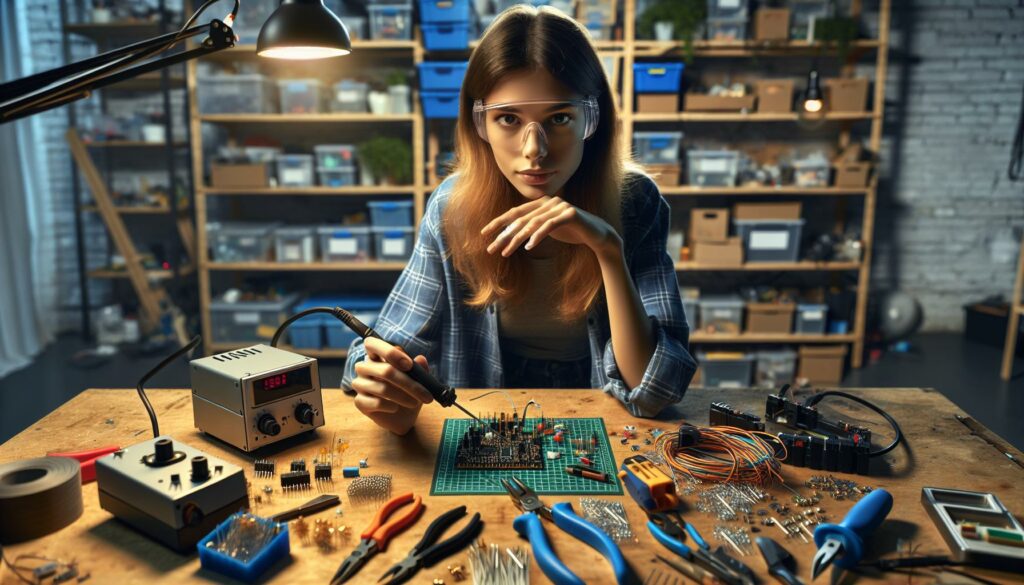There’s something incredibly satisfying about creating your own gadgets and devices. DIY electronic projects not only spark creativity but also enhance your skills in problem-solving and innovation. Whether you’re a seasoned maker or just starting out, these projects can be both fun and educational.
Key Takeaways
- DIY electronic projects foster creativity and skill enhancement, making them suitable for both beginners and experienced makers looking to innovate and solve problems.
- Popular platforms like Arduino and Raspberry Pi offer versatile options for various projects, enabling users to dive into programming and circuit design.
- Key electronics components such as resistors, capacitors, and diodes are essential for successful project execution, emphasizing the importance of understanding basic electronic principles.
- Home automation and robotics are exciting project avenues that integrate multiple technologies, promoting practical applications and real-world skills in networking and programming.
- Safety precautions must be prioritized when engaging in DIY projects, including protective eyewear, proper ventilation, and following detailed guidelines to minimize risks.
- Troubleshooting is a crucial skill in DIY projects; methodical approaches to problem-solving can lead to successful outcomes and deeper understanding of electronic systems.
Cool DIY Electronic Projects
Engaging in DIY electronic projects satisfies creativity and enhances technical skills. Various projects cater to different interests and skill levels, making them ideal for both beginners and experienced makers. Here’s a look at some popular and rewarding DIY electronic projects.
- Arduino Projects
Arduino boards, like the Arduino Uno, serve as versatile platforms for countless electronic projects. I can program these boards to control sensors, motors, and lights, fostering an understanding of programming and circuitry. Examples include building a weather station or creating a smart home automation system. - Raspberry Pi Creations
Raspberry Pi single-board computers facilitate intricate electronics and programming tasks. I can set up media centers, game consoles, or smart mirrors using Raspberry Pi. These projects enhance my knowledge of computer science and electronics while providing practical applications. - LED Displays
LED technology enables dynamic and colorful displays. I can design and build LED sculptures or signs with programmable patterns. Crafting these displays sharpens my soldering skills and understanding of lighting effects, making it enjoyable and visually appealing. - Robotics
Robotics projects combine mechanical components with electronic control systems. I can create robots for various tasks, such as line following or obstacle avoidance. These projects instill teamwork and systematic troubleshooting, proving beneficial in learning both electronics and programming. - DIY Speakers
Building high-quality DIY speakers allows me to explore audio technology. By choosing components like drivers and crossovers, I can optimize sound quality. This project deepens my understanding of acoustics and audio engineering, offering practical insights into sound design. - Home Automation Systems
Creating smart home systems automates daily tasks, enhancing convenience and security. I can integrate devices like lights, cameras, and thermostats, controlled remotely through smartphones. This experience hones my skills in networking, coding, and electronics.
These DIY electronic projects not only spark creativity but also provide valuable skills and knowledge applicable in real-world scenarios. Each project serves as a stepping stone towards mastering electronics, making them both educational and enjoyable.
Essential Tools and Materials
Having the right tools and materials is crucial for success in DIY electronic projects. These essentials can enhance the building process and boost project outcomes.
Basic Tools Every DIYer Needs
- Screwdrivers: Phillips and flathead screwdrivers are necessary for assembling and disassembling components.
- Tweezers: Precision tweezers aid in handling small electronic parts and placing them correctly.
- Wire Cutters: Sharp wire cutters simplify cutting wire and trimming leads, ensuring clean connections.
- Soldering Iron: A reliable soldering iron allows for creating permanent connections between electronic components.
- Multimeter: A digital multimeter measures voltage, current, and resistance, helping diagnose issues effectively.
- Breadboard: A breadboard provides a flexible platform for prototyping circuits without soldering.
- Heat Shrink Tubing: Heat shrink tubing protects connections and insulates wires, preventing shorts.
- Resistors: Various resistors control current flow and voltage levels in circuits.
- Capacitors: Capacitors store and release electrical energy, making them vital in timing circuits and filtering applications.
- Diodes: Used to control current direction, diodes play crucial roles in rectification and protection.
- Transistors: Transistors act as switches or amplifiers, essential for complex circuit designs.
- LEDs: Light Emitting Diodes serve as indicators, providing visual feedback in projects.
- Microcontrollers: Components like Arduino or Raspberry Pi serve as the brain of many DIY projects, enabling programming and interfacing.
- Power Supply: A suitable power supply provides the necessary voltage and current, ensuring projects function correctly.
Top Cool DIY Electronic Projects
I enjoy exploring a variety of DIY electronic projects that cater to different skill levels. Below are some exceptional project ideas for beginners, intermediates, and advanced makers.
Beginner Projects
- LED Blink Circuit: I connect a simple circuit with an LED and a resistor to make the LED blink. This project reinforces basic concepts of circuit design.
- Simple Alarm System: I build a basic alarm system using a buzzer, a switch, and a battery. The project showcases sound circuits and practical applications.
- Temperature Sensor: I create a DIY temperature sensor using an LM35 temperature sensor and an Arduino board. This project introduces analog sensors and data readings.
Intermediate Projects
- RGB LED Strip Controller: I develop a controller for RGB LED strips using an Arduino and MOSFETs. This project enhances programming and electronic components understanding.
- Bluetooth Speaker: I assemble a portable Bluetooth speaker using a Bluetooth module and an amplifier circuit. This project combines audio technology and wireless communication.
- Smart Plant Watering System: I create an automatic plant watering system with moisture sensors and a pump. This project integrates IoT principles and practical automation.
- Home Automation System: I design a comprehensive home automation system that integrates devices like lights and thermostats with a Raspberry Pi. This project focuses on networking and programming.
- Robotic Arm: I build a robotic arm controlled by motors and servos, programmed via Arduino. This project combines mechanics and control systems for intricate movements.
- Drone Build: I construct a DIY drone using a flight controller, motors, and sensors. This advanced project covers aerodynamics and complex circuitry for enhanced flight capabilities.
Tips for Successful DIY Projects
Approaching DIY electronic projects requires strategic planning and a clear understanding of procedures. Here are key tips to enhance your project success.
Safety Precautions
Prioritizing safety is critical in DIY electronic projects. Use protective eyewear to shield your eyes when soldering or cutting components. Keep a fire extinguisher nearby for emergencies, especially when working with soldering irons or open circuits. Ensure your workspace is well-ventilated to avoid inhaling harmful fumes. Unplug devices before making adjustments to prevent electric shocks. Always review project guidelines thoroughly to recognize potential hazards.
Troubleshooting Common Issues
Encountering issues during a project is common. Start by reviewing your circuit connections; ensure all components are properly aligned. Use a multimeter to check for continuity in wires and connections. Inspect for cold solder joints, which can cause intermittent connections. If a component fails, try replacing it with a known working part. Document any changes you make to keep track of what resolves issues. Staying methodical in your approach ensures timely solutions and project progress.


